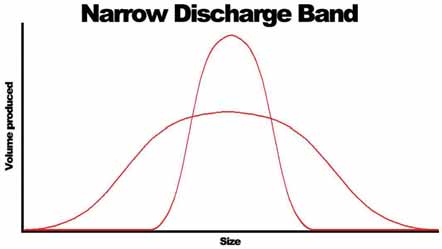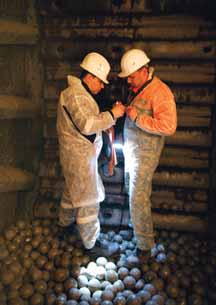
Vibratory grinding mills have been successfully used in tertiary grinding on primary minerals such as iron ores, for example.
Feed materials have been ground to sizes below 200 mesh and some below 325 mesh.

Putting Destructive Vibratory Energy to Productive Use in Grinding
The first vibratory mills to be developed for
material grinding were relatively simple
devices, utilizing an eccentric drive system
mounted to a tube to create an elliptical
motion suitable for attrition grinding. These
devices were limited in throughput and efficiency. They also had complicated drive
connections with very high power consumption per pound of material produced.
General Kinematics began developing
vibratory grinding mills in the 1980s,
applying their knowledge of vibratory sand
reclamation from the foundry industry to
fine grinding applications for other products and materials. Since then, vibratory
grinding mills have undergone an evolutionary process to improve efficiency,
throughput and application. Past experience in utilizing vibration to tumble materials was combined with the energy-saving
capabilities of two-mass drive technology
to create a mechanical device with superior action and grinding efficiency.
When General Kinematics began developing vibratory grinding mills, the initial
goal was to improve the mills’ tumbling
action to help blend and homogenize the
material while maximizing energy input to
grinding. Testing determined the drive
needed to create a linear action off-center
of the grinding body that would create a
rotational point, or node point, around
which the mass would actually vibrate,
thus providing a conveying action inside
the tube and allowing the media to travel
up the active side wall. When the media hit
a point high enough on the tube, gravity
would take effect and cause it to fall back
down upon the media bed.
The net result of this testing was to create a tumbling action somewhat similar to a
normal rotary mill, which blends and mixes
media and material. The difference is that,
simultaneously, individual impact grinding
between all of the media pieces takes place
with every stroke of the mill. A combined
grinding and blending process is created.
The next step in developing vibratory
grinding mills was to incorporate an energy-efficient drive system. The sub-resonant
natural frequency two-mass drive system is
a key feature of all General Kinematics
equipment and was applied in place of a
direct drive on the main vibrating working
mass. The sub-resonant feature tends to
produce more work with less energy, maximizing the use of the energy put into the
system. Energy losses are much less than
those of conventional grinding mills, resulting in better power efficiency. In most
cases, the vibratory grinding mill will use
one-third to two-thirds less kW per lb of
material processed when compared with
rotary and vertical mills.
The action and the drive system are
designed to create a grinding environment
that produces a large number of impacts
due to the vibratory action. Each vibration,
or stroke, of the mill causes the media to expand and separate. This creates gaps in
between the media pieces as well as
between the liner and the media. Each
stroke of the vibratory action provides an
opening and closing of that media.
Sufficient RPM is used to significantly
increase the force being applied due to the
G-forces (the actual dynamic energy that is
being input to the media)—the net result
can be described as “medium energy
impact with high number of impacts per
minute of operation.”
Standard rotary mills use higher energy,
but fewer, impacts. The number of impacts
in a rotary mill is directly related to how
many times the rotation of the machine
can pick up and drop the media to reimpact with other media and the material
to be ground. A vibratory grinding mill will
have several hundred cycles per minute of
media opening and closing. The high number of impacts is combined with speed and
stoke settings to produce up to 5 g’s of
amplification on the media. Thus General
Kinematics vibratory grinding mills create
a higher energy grind due to the use of
their kinetic energy.
Testing has concluded that the true
advantage of this drive configuration is that
enough energy is in place to achieve some
crushing impacts where pieces will actually fracture, but also attrition grinding
occurs in the form of chipping and cleaving edges. These combined grinding
actions contribute a very narrow output
band of material discharge.
Configuration of General Kinematics
vibratory grinding mills is versatile as well,
with the capability to perform in either dry
or wet process grinding. The combined
cleaving and attrition grinding tends to
expose minerals and metals to be recovered
at a faster rate than just grinding material
down to a small particle size. Micro-fractures are generated that will expose the
metal in the particulate without actually
breaking down the encasing material.
Vibratory grinding mills are built to work
with fine grinding and other applications.
Add an in-solution process leaching agent,
and successful grinding and leaching is
achieved at the same time in the mill. This has been a successful solution for many
mines and other applications where an insolution process is necessary. These mills
also can be heated and cooled via waterjacket. With a well enclosed system, fines
are easily captured in an air sweep in the
machine, with minimal leakage or dusting
prevalent. In the case of liquid grinding
applications, vibratory grinding mills are
robust enough to contain liquids, and 2 in.
of water pressure in the drums does not
affect the grind.
The vibratory grinding action allows for
use of almost any solid material as media.
Several media types have been used to date
based on the material to be ground.
Examples of media materials used are steel,
aluminum oxide, zirconia, tungsten carbide
and rubber. A good example is a mill grinding
sintered tungsten carbide using worn and
rejected tungsten carbide inserts from
drilling heads. This example also shows the
flexibility of the vibratory grinding mills to use
a variety of media shapes and sizes. The mills
have used media shapes including round
balls, short cylinders, cones and long rods.
General Kinematics vibratory grinding
mills are easy to install. The two-mass drive
system allows the unit to be heavily isolated
to the support base. This means low dynamic forces to the installation floor and minimal
foundation requirements. Large vibratory
mills have been installed using epoxy anchor
bolts on concrete floors 8–10 in. thick.
Vibratory grinding mills have had extensive success in tertiary grinding on primary
minerals: granites, limestone, iron ores,
hematite and magnetite, for example. Each
of these materials has been ground to sizes
below 200 mesh and some below 325
mesh. At these sizes, the value of base
minerals is significantly increased.
Grinding carbides and tungsten, as well
as zirconium oxide materials and other very
hard to grind materials, fit well within the
vibratory grinding mills process because of
their moderate flow rates. With a feed size
of –1/4, discharge variance of about 120
microns from largest to smallest piece can
be generated. The lower overgrind enables
the ability to achieve a very narrow discharge band, with less energy.
Finally, liner and media life experience
different results within a vibratory grinding
mill. Grinding and attrition mixed together
means energy is being transmitted into the
media, not the liner or machine. Because
the action works media-to-media, there is
very little media-to-liner grinding (see
accompanying table above). Media life
tends to be 30%–50% higher than most
other grinding technologies, especially versus rotary mills in fine grinding applications.
Ronald Fruit is product industry manager in
the technical sales group and Amy L.
Donahue is marketing coordinator for General
Kinematics Corp., 5050 Rickert Road,
Crystal Lake, Ilinois, USA; Telephone: 815-455-3222; www.generalkinematics.com.
Metso monitors grinding mill liner wear
in individual mills with intelligent proprietary software called WearWin, and
continues to develop easy-to-use tools to
reduce mill downtime when physical
inspection is necessary.
For accurate wear estimates, Metso
recommends that the first inspection be
carried out after 25% of the estimated
wear life, the second after 50% and the
third at 75% of expected wear life. This
provides an accurate gauge of the wear
rate and indicates reasonable future liner
change-out intervals.
For example, Berezitovy’s SAG mill
was stopped at 9 a.m one day for an
inspection, and allowing for brief ventilation, two Metso technicians then entered
the mill. Wear on the metallic part of the
lining was measured using an ultrasonic
device, while the remaining thicknesses
of the rubber/Poly-Met parts were measured with a special gauge. Measurements
were taken at a number of selected positions inside the mill. Generally, each
“ring” of the lining is measured with a
special focus on areas that display the
highest wear.
The SAG mill was restarted after 10
a.m., and the collected data was sent to
Sweden by email, where it was input
to the WearWin software. The answer
arrived at the mine site at 4 p.m. local
time on the same day.
In the Berezitovy case, the results
were better than expected—the PolyMet liners installed at the feed end in
January would last longer than estimated and the replacement interval could
be extended by a month. And, after
wear pattern analysis, the replacement
date for the rubber lifter bars, plates
and discharge end liners was extended
even further.
The use of vibration, in combination with grinding media, for material size reduction
significantly increases the number of material impacts per minute, decreasing
product-extraction time and creating a more desirable fractured product
By Ronald Fruit and Amy Donahue


The combined grinding actions generated by vibratory mills results in a very narrow output band of material
discharge.

Denis Demenok, head of Metso’s local service
department (left), and Artem Askhadulin, Metso
Mining sales,
measure liner wear inside a mill.
As featured in Womp 2014 Vol 02 - www.womp-int.com